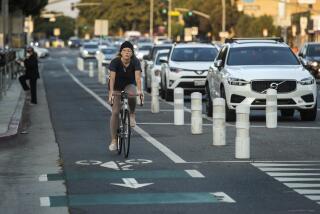An above-ground solution for Wilshire traffic
- Share via
THERE’S NO question that we need alternatives to sitting in L.A. traffic, and the Wilshire Boulevard corridor is as good a place as any to start.
While the continuation of the Red Line subway along Wilshire championed by Los Angeles Mayor Antonio Villaraigosa and others is a worthy goal, the project’s $5-billion cost is staggering. Even if the money is found, the 10 years it would take to construct is too long to wait for a solution to our worsening congestion there. Why not improve what’s already working on Wilshire: Metro Rapid Line 720, which boasts about 50,000 boardings a day between East L.A. and Santa Monica?
The Metropolitan Transportation Authority’s BRT (or “bus rapid transit”) experiment on Wilshire and in other parts of the city is like a bus system on steroids. In order to approximate the speed and capacity of a more expensive urban rail system, the Metro Rapid buses exploit their advantage over conventional MTA buses by scheduling more frequent service, fewer stops, coordination with subway station locations and even a device that extends a green light for an approaching bus.
Now, transit planners want to make the Metro Rapid system even more productive by installing a dedicated bus lane along Wilshire and implementing a prepaid fare system, similar to the Valley’s Metro Orange Line. These improvements could cut bus travel time between downtown Los Angeles and Santa Monica by an estimated 20% to less than 50 minutes, making a Wilshire BRT line competitive with a subway.
However, there are complaints about traffic problems and the temporary loss of business during construction. There are also concerns about the permanent loss of street parking if the curb lane is used for buses or, alternatively, the destruction of Wilshire’s signature planted median if center lanes are created for the buses. These objections are threatening to derail both the MTA’s current one-mile pilot project in West L.A. and the entire Wilshire plan.
Local officials now considering the fate of the bus lane ought to look at how Bogota, Colombia — a metropolis of nearly 7 million residents — tackled its traffic problems. Former Mayor Enrique Peñalosa spearheaded a 300-mile system of bus lanes, bicycle paths and pedestrian streets that is widely credited with dramatically reducing urban traffic. By 2005, there was a 32% reduction in commute times and a 40% drop in air pollution, according to one study.
The success in Bogota has shown that bus rapid transit is a proven solution for moving people efficiently. New York and San Francisco, cities with mature rail systems, have recently announced plans to build bus rapid transit lines using dedicated lanes. All this suggests that before we consider spending $5 billion — and waiting at least 10 years — for a subway, Los Angeles should be investing a fraction of that sum to create a first-class BRT system on Wilshire by the end of 2008.
The MTA estimates that it would cost $232 million to complete the dedicated lane on Wilshire. The savings over a subway system would be more than enough to justify spending money on replacement parking, traffic management, transitional assistance for affected businesses and more trees to replace the planted medians.
Dedicating road space to bus riders makes transit work better for everyone, and it ultimately benefits motorists by reducing the number of cars on the road. Instead of caving into parochial interests, county and city officials should push for dedicated lanes along all of Wilshire Boulevard.
More to Read
Sign up for Essential California
The most important California stories and recommendations in your inbox every morning.
You may occasionally receive promotional content from the Los Angeles Times.










